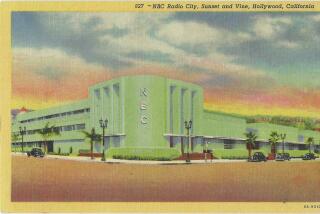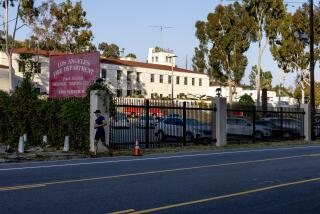War Didn’t Trigger Ratings for News-Oriented KSDO
Local radio executives are using words like “weird” and “strange” to describe the Arbitron ratings report released last week, which was expected to reflect the impact of the Gulf War on local listening habits.
The war started Jan. 16, just a few days after the start of the ratings period. While most stations scrambled to hook up with local television news operations or to find some way of presenting timely news to its listeners, the stations with news formats, particularly KSDO-AM (1130), appeared to be in an ideal situation.
But it was a lousy ratings book for KSDO.
Among listeners 12 and over, KSDO actually dropped from a 6.6 rating to a 5.9. Around the country, predictions were proven correct, as news-talk stations put up big ratings numbers, but it is a phenomenon that apparently missed KSDO--at least according to the ratings book.
“I really don’t know why” it happened, said KSDO general manager Mike Shields. “It’s the luck of the draw with this ratings service.”
Other news outlets fared better. KFMB-AM jumped from a 4.0 to a 5.1, a number it usually achieves only when it airs Padres games. Perhaps listeners were just showing their appreciation for KFMB airing less of the cheesy morning team of Hudson and Bauer, but there is no doubt the war played a big part in the ratings number.
KPBS-FM, the public broadcasting station, showed some sound commercial instincts, capitalizing on the war by moving ahead with its planned switch to a news/talk format. They were rewarded with a solid 7.7 rating, up from a 5.8 the previous quarter.
But the war didn’t have a corresponding negative impact on the non-news stations. The dance tunes of KKLQ (Q106) stayed at about the same level as the previous quarter with a 7.4 rating, and KSON, which simulcasts a country format on AM (1240) and FM (97.3), also stayed about the same, posting a solid 6.2 rating in the 12 and over category.
“It’s a strange book,” said KSON promotions director Steve Sapp. “We figured people’s listening habits may change more toward the news stations and effect the non-news stations, but it didn’t happen.”
The KSDO ratings were definitely the talk of the industry. The station won the morning time period, posting an 8.1 rating among listeners 12 and over. But the audience for the midday period, which primarily covers Roger Hedgecock’s show, plummeted from 14,000 in February to 3,400 in March. Even if San Diegans all suddenly decided at the same time that Hedgecock is a parody of a talk-show host, there is no rational explanation for such a dramatic drop.
However, as for KSDO’s overall rating, it is interesting to note that Los Angeles-based all-news station KNX posted a solid 2.6 rating in the San Diego book.
Last June, the management of KPBS justified staff layoffs by citing a growing financial crisis, primarily the rising cost of programming. That seems like long ago.
The public broadcasting station recently sent out press releases touting a near-record membership drive in the first part of ‘91, aided by popular programs like “The Civil War.” And the annual budget report published in last month’s edition of “On Air,” the station’s monthly magazine, showed that the station’s revenues increased by more than $1.2 million in the 1990 fiscal year, while the cost of programming services went up only $551,000.
On paper, it doesn’t look like much of a crisis.
However, KPBS administration manager Horst Bruenjes says the revenue increase came from sources that the station can’t count on in the future. The amount of private grants and underwritings more than doubled in 1990, from $569,274 to $1,137,238, and the station reaped a $292,00 windfall by cashing in an investment. The underwritings will probably stay about the same during the next year, while the donation from San Diego State University is expected to drop. At the same time, programming costs are increasing and the station is striving to replenish its cash reserves, depleted by operating losses in the past two years, Bruenjes said.
Membership revenues have increased by “10% to 12%” this year, but that’s not enough to offset the earlier projections, Bruenjes said.
Of course, looking at the overall picture--including the layoffs and the past deficit--leaves the distinct impression that KPBS is a station attempting to make up for past mistakes.
KGTV (Channel 10) reporter Michael Finney has left to to take a job with KGO-TV in San Francisco. Finney had another year left on his Channel 10 contract, but he wanted to be closer to his mother, who is ill. . . .
Meanwhile, Channel 10 has been using former Urban League head Herb Cawthorne as a weekend anchorman. He’s “on trial,” according to Channel 10 news director Paul Sands. “It’s on a temporary basis, nothing permanent.” Cawthorne has definitely improved as a news reader, but he emotes the sincerity of a used-car salesman. . . .
Steven Bosh, a veteran of stints in Dallas, Pittsburgh and New York, among others, is the new KUSI-TV (Channel 51) weekend anchor. He’s been sitting in with George Reading on weeknights, but the station is still looking for a regular co-anchor to team with Reading, someone with the type of background and journalistic skills that will fit in with the tone and style of the Channel 51’s newscast--i.e. someone who will work cheap. . . .
Four days before Sam Donaldson attacked Kitty Kelley on national television about her Nancy Reagan book, Makeda Cheatom used her Sunday night reggae show on XTRA-FM (91X) to confront writer David Stampone about an article he wrote in the Reader about the need for more diversity on the local reggae scene. It may not have had the luster of Sam versus Kitty, but sparks were flying. “Why do we have to read negative journalism?” Cheatom asked.
More to Read
The biggest entertainment stories
Get our big stories about Hollywood, film, television, music, arts, culture and more right in your inbox as soon as they publish.
You may occasionally receive promotional content from the Los Angeles Times.










